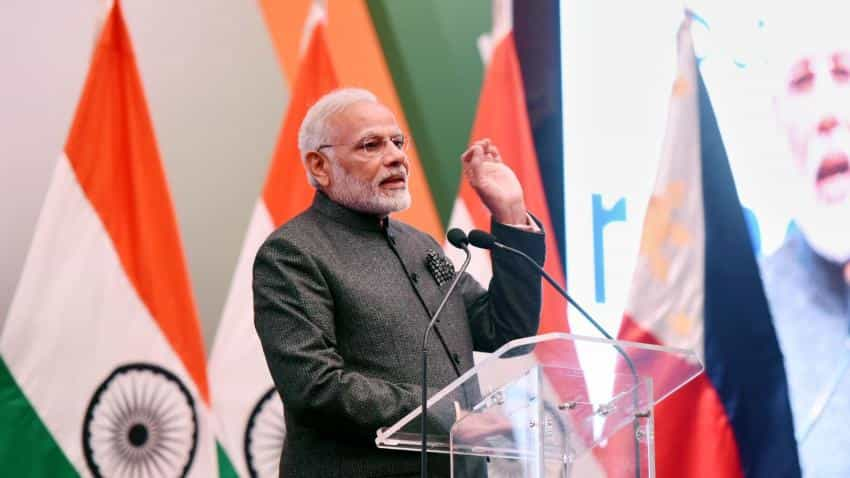GST, Direct Benefit Transfer, demonetisation to ‘foster sustainable growth’ in India, Moody’s says
Recent reforms undertaken by the government of India provided 'greater confidence' that the high level of public indebtedness which is India's principal credit weakness will remain stable, Moody's said.

Key Highlights
- From the lowest investment ranking of Baa3 India has been rated Baa2 by Moody's.
- The agency has changed the nation's outlook to 'stable'.
- Rationale for the Moody’s ranking was cited as the risks to India's credit profile were broadly balanced.
After much ado was made by the BJP led government in 2016 over the lowest investment grade ranking, India has now received a Baa2 ranking by Investor Service, Moody’s on Friday.
While allotting a ‘stable’ outlook to the Indian economy the agency pointed out that the reforms by the government will ‘foster sustainable growth’.
“The government is mid-way through a wide-ranging program of economic and institutional reforms. While a number of important reforms remain at the design phase, Moody's believes that those implemented to date will advance the government's objective of improving the business climate, enhancing productivity, stimulating foreign and domestic investment, and ultimately fostering strong and sustainable growth,” Moody’s said.
Last year, India received the lowest investment grade rating of Baa3 which was teamed with ‘a positive outlook,’ by Moody’s. Post which the Indian government criticised the ratings methods used and pushed for an upgrade.
In October 2016, the Finance Ministry wrote letters to the Investor Service organisation questioning its method and saying it was not accounting for a steady decline in the India’s debt burden in recent years.
Now that Moody’s has changed its rating the chief economic advisor, Arvind Subramanian said, “It's a welcome development but we also feel it was long overdue. It's a recognition of the actions the government has undertaken on GST, bankruptcy and all of that.”
सरकार के रिफॉर्म का असर दिखने लगा है | #Moody's के बाद दूसरी एजेंसियों से भी रेटिंग बढ़ाने की उम्मीद @arvindsubraman @FinMinIndia pic.twitter.com/Me6sKEEUgO
— Zee Business (@ZeeBusiness) November 17, 2017
"Government of India welcomes the upgrade and believes, as rightly noted by the Moody’s that this is in recognition of major economic and institutional reforms undertaken by Government of India," the government said in a statement.
Moody’s rating was also welcomed by Revenue Secretary, Hasmukh Adhia who tweeted out, “The path that Government has chosen for long term reforms and fiscal consolidation is well recognised by investors already. The rating agency too has now confirmed it formally, which is welcome.”
However, member of the Economic Advisory Council to the Prime Minister (EAC-PM) Rathin Roy had this to say.
Those celebrating the ratings upgrade note that the rationale was the expected reduction in the government DEBT to GDP ratio. Cry unfair or erroneous, but an FRBM that signals this is important. 1/2 @FinMinIndia @SecretaryDEA @NKSingh_MP @arvindsubraman
— rathin roy (@EmergingRoy) November 17, 2017
Moody’s cited a ‘reform program’ which will complement the existing shock-absorbance capacity provided by India's strong growth potential and improving global competitiveness.
“Key elements of the reform program include the recently-introduced Goods and Services Tax (GST) which will, among other things, promote productivity by removing barriers to interstate trade; improvements to the monetary policy framework; measures to address the overhang of non-performing loans (NPLs) in the banking system; and measures such as demonetization, the Aadhaar system of biometric accounts and targeted delivery of benefits through the Direct Benefit Transfer (DBT) system intended to reduce informality in the economy,” the report said.
Rationale for the Moody’s ranking was cited as the risks to India's credit profile were broadly balanced.
The ratings agency said that real GDP growth will improve only with disruption from GST and demonetisation fading from the economy.
“Moody's expects real GDP growth to moderate to 6.7% in the fiscal year ending in March 2018 (FY2017). However, as disruption fades, assisted by recent government measures to support SMEs and exporters with GST compliance, real GDP growth will rise to 7.5% in FY2018, with similarly robust levels of growth from FY2019 onward,” the report added.
The government debt stood at 68% of GDP in 2016, which Moody’s said was significantly higher than the Baa median of 44%.
However now the tides have changed for India.
“The impact of the high debt load is already mitigated somewhat by the large pool of private savings available to finance government debt. Robust domestic demand has enabled the government to lengthen the maturity of its debt stock over time, with the weighted average maturity on the outstanding stock of debt now standing at 10.65 years, over 90% of which is owed to domestic institutions and denominated in rupees,” the report said.
From this ‘stable’ outlook, Moody’s said the ratings could move upwards on account of ‘material strengthening in fiscal metrics, combined with a strong and durable recovery of the investment cycle, probably supported by significant economic and institutional reforms.’
Or India’s rating could face a downward pressure as well.
“A material deterioration in fiscal metrics and the outlook for general government fiscal consolidation would put negative pressure on the rating. The rating could also face downward pressure if the health of the banking system deteriorated significantly or external vulnerability increased sharply,” Moody’s added.
01:42 PM IST






 Equity markets open in green as Moody’s elevates India's rating to Baa2
Equity markets open in green as Moody’s elevates India's rating to Baa2 Moody's gives Modi a boost by raising India's sovereign bond rating
Moody's gives Modi a boost by raising India's sovereign bond rating